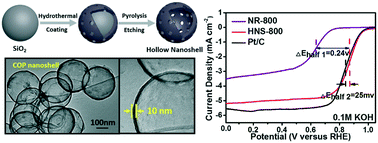当前位置:
X-MOL 学术
›
React. Chem. Eng.
›
论文详情
Our official English website, www.x-mol.net, welcomes your
feedback! (Note: you will need to create a separate account there.)
Controlled synthesis of porous nitrogen-doped carbon nanoshells for highly efficient oxygen reduction†
Reaction Chemistry & Engineering ( IF 3.4 ) Pub Date : 2017-12-19 00:00:00 , DOI: 10.1039/c7re00178a Lei Shi 1, 2, 3, 4, 5 , Peng Peng 1, 2, 3, 4, 5 , Zhonghua Xiang 1, 2, 3, 4, 5
Reaction Chemistry & Engineering ( IF 3.4 ) Pub Date : 2017-12-19 00:00:00 , DOI: 10.1039/c7re00178a Lei Shi 1, 2, 3, 4, 5 , Peng Peng 1, 2, 3, 4, 5 , Zhonghua Xiang 1, 2, 3, 4, 5
Affiliation

|
Hollow nanostructures, owing to their unique structural features, have attracted tremendous attention in electrochemical energy storage and conversion. Herein, we develop a facile and controllable, but rational and effective, method to prepare a highly active hollow nitrogen-doped carbon nanoshell (termed as HNS-800) oxygen reduction electrocatalyst. The hollow nano-shelled catalyst was synthesized by using 9,11,20,22-tetraaza-tetrapyridopentacene (tatpp) as the building block and coated with silica nano-spheres as the template, followed by carbonization at 800 °C and finally chemical etching. The average thickness of the nanoshell is ∼10 nm and about three times improvement in the specific surface area (from 253 to 647 m2 g−1) was obtained owing to the formation of the nanoshell structure. Compared with the traditional solid nanorod structure prepared without the controlled template (termed as NR-800), the newly formed hollow nanoshell structure contributed to the huge promotion of ORR in both alkaline and acidic media. The as-obtained HNS-800 exhibited very efficient activity with a high kinetic current density (Jk) of 18.02 mA cm−2 at 0.8 V vs. RHE and a small Tafel slope of 69 mV dec−1. In particular, the half-wave potential of HNS-800 (0.87 V vs. RHE) was higher by 25 mV than that of the benchmark Pt/C in 0.1 M KOH. Unlike the commercial Pt/C electrode, the HNS-800 electrocatalyst was almost free from the methanol crossover effect and showed a better stability.
中文翻译:

受控掺杂的氮掺杂碳纳米壳的合成,可实现高效氧还原†
中空纳米结构由于其独特的结构特征,在电化学能量存储和转换中引起了极大的关注。本文中,我们开发了一种容易且可控但合理有效的方法,以制备高活性的中空氮掺杂碳纳米壳(称为HNS-800)氧还原电催化剂。以9,11,20,22-四氮杂-四吡啶并戊并四苯(tatpp)为结构单元并涂覆二氧化硅纳米球作为模板,然后在800°C的温度下碳化,最后进行化学蚀刻,从而合成了中空的纳米壳催化剂。 。纳米壳的平均厚度约为10 nm,比表面积提高了约三倍(从253到647 m 2 g -1由于形成了纳米壳结构,因此获得了)。与不使用可控模板的传统固体纳米棒结构(称为NR-800)相比,新形成的中空纳米壳结构有助于在碱性和酸性介质中极大地促进ORR。将如此得到的HNS-800具有高动能的电流密度(表现出非常有效的活性Ĵ ķ的18.02毫安厘米)-2为0.8V与RHE和69毫伏癸小塔菲尔斜率-1。特别是HNS-800的半波电势(0.87 V vs.RHE)在0.1 M KOH中比基准Pt / C高25 mV。与商用Pt / C电极不同,HNS-800电催化剂几乎没有甲醇交叉效应,并显示出更好的稳定性。
更新日期:2017-12-19
中文翻译:

受控掺杂的氮掺杂碳纳米壳的合成,可实现高效氧还原†
中空纳米结构由于其独特的结构特征,在电化学能量存储和转换中引起了极大的关注。本文中,我们开发了一种容易且可控但合理有效的方法,以制备高活性的中空氮掺杂碳纳米壳(称为HNS-800)氧还原电催化剂。以9,11,20,22-四氮杂-四吡啶并戊并四苯(tatpp)为结构单元并涂覆二氧化硅纳米球作为模板,然后在800°C的温度下碳化,最后进行化学蚀刻,从而合成了中空的纳米壳催化剂。 。纳米壳的平均厚度约为10 nm,比表面积提高了约三倍(从253到647 m 2 g -1由于形成了纳米壳结构,因此获得了)。与不使用可控模板的传统固体纳米棒结构(称为NR-800)相比,新形成的中空纳米壳结构有助于在碱性和酸性介质中极大地促进ORR。将如此得到的HNS-800具有高动能的电流密度(表现出非常有效的活性Ĵ ķ的18.02毫安厘米)-2为0.8V与RHE和69毫伏癸小塔菲尔斜率-1。特别是HNS-800的半波电势(0.87 V vs.RHE)在0.1 M KOH中比基准Pt / C高25 mV。与商用Pt / C电极不同,HNS-800电催化剂几乎没有甲醇交叉效应,并显示出更好的稳定性。











































 京公网安备 11010802027423号
京公网安备 11010802027423号